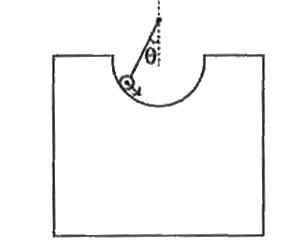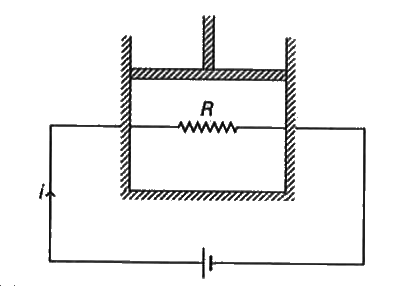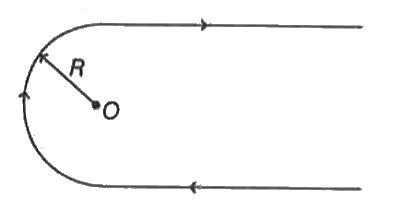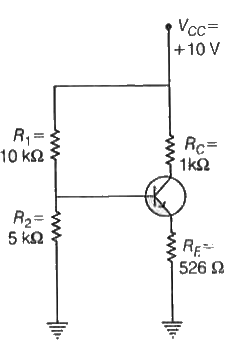Complete Solutions to PHYSICS of chapter ONLINE QUESTION PAPER of Class 12 book with complete answers and questions
| Class 12 | PHYSICS |
| Chapter | ONLINE QUESTION PAPER |
| TS EAMCET | PHYSICS |
| Number Of Questions | 40 |
| Academic Year | 2023-24 |
A nucleus of deuterons or deuterium is a bound atomic system best described by
View SolutionA wooden cubical block of mass, m = 20 kg is measured within an error of 10g. Its side length, l = 100 cm is measured within an error of 1 mm. Then, the relative error in the measurement of its density is
View SolutionA vehicle starts moving in a straight line with an acceleration, `a = 4 m//s^(2)`, with initial velocity equal to zero. After accelerating for time `t_(1)`, the vehicle moves uniformly and for time `t_(2)`, the vehicle finally decelerates for time, `t_(1)` eventually coming to a stop. The total time taken during the motion is 10s and the average velocity during the motion is 5.1 m/s. The time taken by the vehicle during acceleration is
View SolutionA body travels in a straight line from point A to point B with an initial velocity zero and uniform acceleration, covering 1m during the first second and 39m during the last second. The distance between A and B in metre is
View SolutionA cricket player can throw a ball with an initial speed of 30 m/s. What is the maximum range of the player can throw the ball? Neglect air reistance. [Take g =`10 m//s^(2)`]
View SolutionA particle moves in XY-plane with x and y varying with time t as x(t) = 5t, y(t) = `5t (27 -t^(2))`. At what time in seconds, the direction of velocity and acceleration will be perpendicular to each other ?
View SolutionA bullet enters in a piece of wood with velocity `v_(0)` and the resistive force acting on the bullet in the vood is proportional to `v^((1)/(3))`. If the total distance travelled by the bullet is proportional to `(v_(0))^(beta)`, then the value of `beta` is
View SolutionA mechanical system constans two springs of stiffness coefficients `k_(1) and k_(2)` are connected in series. The minimum work to be performed on the system to stretch it by `Delta l` is
View SolutionA block of mass 5 kg is pulled by a force F as shown in the figure. If the coefficient of friction is 0.1, then te force needed to accelerate the block to `3 m//s^(2)` to the right is close to

View SolutionA particle of mass m kg moves along the X-axis with its velocity varying with the distance travelled as `v= kx^(beta)`, where k is a positive constant. The total work done by all the forces during displacement of the particle for x = 0 to x=d is close to
View SolutionThe masses and positions (in rectangular coordinates) of four particles are as follows: 1kg at (a, a), 2kg at `(-a,a)`, 3kg at `(-a,-a)` and 4kg at (a, -a). The position vector of the centre of mass of the system of four particles is
View SolutionA solid sphere is rolling without slipping on a semi-circular track of radius 10m as shown in the figure. The radius of solid sphere is much smaller than the radius of semi-circular track. At the lowest point, it has a velocity 10 m/s. To what maximum angle `theta` from the vertical will the sphere travel before it comes back down? Neglect the rolling friction between the sphere and the track. (Take `g= 10 m//s^(2)`)

View SolutionA block of mass `(10 alpha)`, where `alpha` is a constant is moving with velocity 3 m/s to the right collides inelastically with the block on the right with mass 10g and sticks to it. The right block is connected to three springs as shown in the figure. The spring constant of each spring is 2N/m. If the amplitude of the resulting simple harmonic motion is `(1)/(2 sqrt2)m`, then the value of `alpha` is

View SolutionThe density inside a solid sphere of radius r varies as `rho (r ) = rho_(0) ((r )/(R ))^(beta), " where " rho_(0) and beta` are constants and r is the distance from the centre. Let `E_(1) and E_(2)` be gravitational fields due to sphere at distance `(R )/(2)` and 2R from the centre of sphere. If `(E_(2))/(E_(1)) =4`, teh value of `beta` is
View SolutionThe pressure to be applied to the ends of a steel cylinder to keep its length constant upon raising its temperature by `100^(@)C` is (thermal expansion coefficient, `alpha = 11 xx 10^(-6)//K`, Young's modulus = 200 GPa)
View SolutionThe root mean squae (rms) velocity of an ideal gas at temperature T is v. If the temperature is increased to 4T, the rms velocity of the gas is
View SolutionA glass beaker contains 200g of carbonated water initially at `20^(@)C`. How much ice should be added to obtain the final temperature of `0^(@)C` with all ice melted, if the initial temperature of ice is `-10^(@)C`. Neglect heat capacity of glass. [Take, `C_("water")= 4190J//kg^(@)C`,
`C_("ice") = 2100J//Kg^(@)C, L_(P) = = 3.34 xx 10^(5)J//Kg`]
View SolutionHeat loss takes place from a body maintained at a temperature of `400^(@)C` to the surrounding air at `30^(@)C` by convection and to the surrounding surfaces at `30^(@)C` by radiation. The Newton's cooling coefficient is 20 `W//m^(2)` K and the Stefan-Boltzmann constant is `5.67 xx 10^(-8) W//m^(2)K^(4)`. If the rate of heat loss by convection is equal to the rate of heat loss by radiation, the emissivity of the body surface is
View SolutionA carnot engine absorbs heat from a reservoir maintained at temperature 1000K. The engine rejects heat to a reservoir whose temperature is T. If the magnitude of a absorbed heat is 400J and work performed is 300J, then the value of T is
View SolutionThe mean kinetic energy of monoatomic gas molecules under standard conditions is `(E_(1))`. If the gas is compressed adiabatically 8 times to its initial volume, the mean kinetic energy of gas molecules changes to `(E_(2))`. The ratio `((E_(2)))/((E_(1)))` is
View SolutionThe speed of a transverse wave on a string is 160m/s. If the three resonant frequencies of this string respectively are 160Hz, 240Hz and 400Hz, the length of the string is
View SolutionConsider a concave mirror of 10 cm focal length illuminated by an object kept at a distance of 25 cm. The distance at which the image is formed and its magnification respectively are
View SolutionTwo objects P and Q are placed at 10 cm and 30 cm infront of a convex lens of focal length 20 cm. The correct option for the image of P and Q is
View SolutionCalculate the minimum thickness of a soap film (n= 1.33) that results in constructive interference in reflected light, if the film is illuminated with light whose wavelength in free space is 532 nm.
View SolutionA thin spherical shell encloses a concentric solid sphere. The radius of the shell is `(0.060)^((1)/(2))`m and its surface charge density is `-10^(-6)C//m^(2)`. The radius of the solid sphere is `(0.01)^((1)/(3))m` and its volumetric charge density is `3 xx 10^(-5)C//m^(3). epsi_(0)` is the permittivity of free space in `C^(2)//Nm^(2)`. The electric flux through a spherical surface concentric with the spherical shell and of radius greater than that of the shell in V-m is
View SolutionA conducting sphere `S_(1)` of radius `r_(1)` is connected by a conducting wire to another conducting sphere `S_(2)` of radius `r_(2)`, where `r_(1) = 3 cm and r_(2) = 2` cm. Before they are connected, `S_(1)` carries charge of 10 units. The electric potential at the point which is at a distance 4 cm from the centre of `S_(1)` and a distance 3 cm from the centre of `S_(2)` is
View SolutionA `500 Omega` resistor connected to an external battery is placed inside a thermally insulated cylinder fitted with a frictionless pistion. The cylinder contains an ideal gas. A current i of 200mA flows through the resistor as shown in the figure. The mass of the piston is 10kg. Assuming `g = 10m//s^(2)`, the speed at which the piston will move upward, due to heat dissipated by the resistor, so that the temperature of the gas remains unchanged is

View SolutionA cylindrical shape resistance is connected to a battery with emg 5V. The resistance per unit length varies as `rho(x) = rho_(0) ((x)/(L))^(alpha)`, where `rho_(0) and alpha` are constant and x is the distance from one end of the resistor. The magnitude or product `rho_(0)L " is " 10 Omega`, where L is the length of the resistor. If the thermal power generated by the resistor is 20W, then the value of `alpha` is
View SolutionConsider a current carrying wire shown in the figure. If the radius of the curved part of the wire is R and the linear parts are assumed to be very long, then the magnetic induction of the field at the point O is

View SolutionA charged particle moves with some initial velocity along the direction of external magnetic field B. Now, If we apply uniform field perpendicular to the magnetic field, then the trajectory of the charged particle will be
View SolutionA magnetic dipole is under the influence of two orthogonal magnetic fields, `B_(1) = 0.5 xx 10^(-3) T and B_(2) = 0.866 xx 10^(-3)T`. If the dipole comes to stable equilibrium at an angle `theta` with respect to `B_(2)` field, then the value of `theta` is
View SolutionA wheel with radial metal spokes 1 m in length is rotated in a magnetic field of `0.5 xx 10^(-4)T` normal to the plane of the wheel. If the induced emf between the rim and axle is `pi//3000V`, then the rotational speed of the wheel in revolutions per minute is
View SolutionAn initially charged undriven LCR circuit having inductance L, capacitance C and resistance R will be
View SolutionAn electromagnetic wave having frequency `4 xx 10^(14)Hz` is passing through a small volume. The energy contained in this volume oscillates with frequency.
View SolutionLight of frequency `4 xx 10^(14)Hz` is incident on a metal surface of work function 2.14 eV, resulting in photoemission of electrons. The maximum kinetic energy of the emitted electrons is `[h = 6.63 xx 10^(-34)J-s]`
View SolutionIf a proton is accelerated through a potential difference of 1000V, then its de-Broglie wavelength is (given, `m_(p) = 1.67 xx 10^(-27)kg, h = 6.63 xx 10^(-34)J-s`)
View SolutionIn uranium radioactive series, initial nucleus `""^(238)U_(92)` decays to final nucleus `""^(206)U_(82)`. In this process, the number of `alpha`-particles and `beta`-particles emitted are
View SolutionDetermine `V_(CE)` in the following silicon based transistor circuit

View SolutionThe voltage-current characteristic of a diode during forward bias is given by `I = 7.8 xx 10^(-5) e^(6.9V_(D))`, where I is the current in mA and `V_(D)` is the diode voltage in V. Find the dynamic resistance of the diode in `Omega`, when the current is 4mA.
View SolutionThe height of a transmission antenna is 49m and that of the receiving antenna is 64m. What should be the maximum distance between them for line of sight transmission ?
View Solution
PHYSICS questions and complete solutions for chapter ONLINE QUESTION PAPER of TS EAMCET PREVIOUS YEAR PAPERS of Class 12